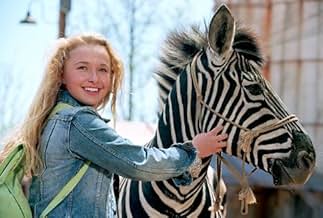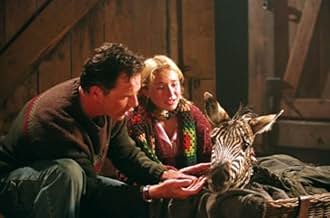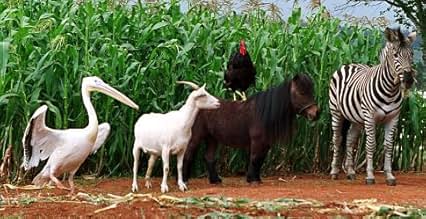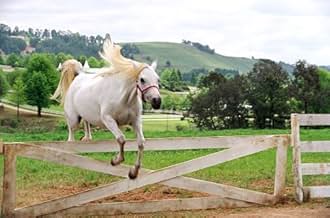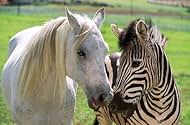IMDb RATING
5.2/10
19K
YOUR RATING
An abandoned zebra grows up believing he is a racehorse, and, with the help of his barnyard friends and a teenage girl, sets out to achieve his dream of racing with thoroughbreds.An abandoned zebra grows up believing he is a racehorse, and, with the help of his barnyard friends and a teenage girl, sets out to achieve his dream of racing with thoroughbreds.An abandoned zebra grows up believing he is a racehorse, and, with the help of his barnyard friends and a teenage girl, sets out to achieve his dream of racing with thoroughbreds.
- Awards
- 3 nominations total
Featured reviews
Although the humor is a bit sophomoric and the story predictable, Racing Stripes had my 7 and 9 year old grandsons giggling. Since they are probably the target audience, the movie was successful. I am more concerned when Hollywood inserts unnecessary inappropriate language into an otherwise suitable movie to satisfy someone's idea of reality or sophistication. Please refer to the "Francis the Talking Mule" films which were admittedly cheesy, but rather hilarious. I recently saw one for the first time in over 40 years and realized it was still funny. A key element in a movie of this type is to have good people (or animals) to root for.
If you strongly dislike films that are predictable, clichéd or derivative, and you're not showing Racing Stripes to kids, you should avoid this movie. Well, at least looking at things somewhat pessimistically. Ideally, you should sort out the conceptual errors you're making and see the movie, because it is a very good film. The Cult of Originality had it wrong. Artworks aren't inherently more valuable just because they're unprecedented, and they're not inherently less valuable just because they're engaging in a well-established form, or "template", to put it in more modern terms.
Stripes is a zebra who is orphaned at the beginning of the film when a traveling circus accidentally leaves him behind during a storm. Nolan Walsh (Bruce Greenwood) finds him and brings him back to his Kentucky farm (actually South Africa doubling as Kentucky). Walsh, a recent widower, has a teenaged daughter, Channing (Hayden Panettiere), who works at the local horse track for a mean, snooty and rich boss lady, Clara Dalrymple (Wendie Malick). The horse track is the heart of the town. The farm next door to the Walsh's breeds racehorses, and in fact, Walsh used to breed and train racehorses, too, for Clara, and it's implied that Walsh's wife, a former champion jockey, died in a horse-racing accident.
Meanwhile, Stripes is trying to adjust to life on the Walsh farm, which means assimilating with a motley crew of animals. All of the animals can talk to each other, "Mister Ed" (1961)-style, but in the more traditional filmic instantiation of talking animals, they can't talk to humans, although it is implied that they can at least slightly understand human speech. Stripes knows he looks different, but he figures he's a horse, like the racehorses next door, because that's what he looks closest to. Their teasing because he looks different merely creates a stronger desire for him to fit in and even best them, which naturally means a growing desire to race.
Any older cinephile could probably fill in the basic developments of the plot, up to and including the ending, given the premises above. The important consideration is not whether Racing Stripes is unprecedented, but how well it does what it sets out to do. The formulaic aspects of the plot, as with all artworks that engage with some traditional "formula", enhance Racing Stripes rather than detracting from it by (a) filling in a deep milieu of shared meaning, signifiers and so on, and (b) underscoring the ways in which Racing Stripes makes its variations on the form. It's a good film both because it executes the basics of the form so well and because the variations are well done, creative and entertaining. That's if you're an adult, at least. For younger audiences, it's a great film because it's establishing the form in their minds. The form exists as a template because it's a very effective, classic plot rooted in a particular kind of cultural mythology. But this instantiation is simply a funny, inspirational story featuring a talking zebra.
Filmic visual manipulation has come a long way in the 40 years since "Mister Ed". Mister Ed, the original talking horse, was made to "speak" by putting something in his mouth that he would then try to remove. In Racing Stripes, the animal speech is all done through cgi--actually computer animation/manipulation of cinematographic images of the animals' mouths, and it looks incredibly realistic. Like most movies of this sort, Racing Stripes is a pleasure to watch simply for its animal stunts. I suppose one can never get too old or intellectual to enjoy a dancing monkey, so to speak. There are a few instances of animal "stunts" being too dangerous for the animals--such as Stripes' wipeout, so these are animated with cgi, too, and they're integrated very well.
There are also two completely cgi-animated characters--flies named Buzz and Scuzz. These are the most consistently comic characters, although as flies, a lot of their visual humor, at least, hinges on jokes about things like garbage, discarded food, manure, and so on.
The animals are voiced by an all-star cast. Director Frederik Du Chau, in his first live-action film (and only his second film), does an excellent job creating performances from the animals that match the public personalities of the voices. Stripes is Frankie Muniz, and has his innocent precociousness. Dustin Hoffman is an older, small horse named Tucker who provides advice and inspiration, a bit like a cynical Buddha. Snoop Dogg is the family hound, naturally enough, and tends to lie on the porch, chilling out and making sarcastic remarks. Joe Pantoliano is Goose--he made a wrong turn in New Jersey and is now comically trying to pass himself off as a gangster. The flies are David Spade and Steve Harvey, with Spade doing his infamous manic-but-mellow naivety. The human cast is good, too, but they're really ancillary to the animals. Older cinephiles will especially delight in seeing M. Emmet Walsh as a rumpled "track-rat".
As a film primarily targeted at kids and younger teens (although it's certainly not enjoyable only to them--I'm middle-aged and have no kids), Racing Stripes has a couple "moral of the story" subtexts, and as usual, they're themes that not only kids can benefit from internalizing. The primary theme is acceptance of difference. Stripes is unlike any being the other animals have encountered, and naturally he is teased, made fun of, ostracized and even physically abused because of it. The gist of the plot is a demonstration that difference isn't negative. This is often interpreted as a racial theme, but it's really more general than that, applying to all kinds of differences. The other main theme, acceptance of loss and confrontation of the resultant depression, fear and anger, arrives via Walsh.
Cute, funny, heartwarming and a subtly surreal fantasy, Racing Stripes is a great example of why predictability just doesn't matter when it comes to making a good film.
Stripes is a zebra who is orphaned at the beginning of the film when a traveling circus accidentally leaves him behind during a storm. Nolan Walsh (Bruce Greenwood) finds him and brings him back to his Kentucky farm (actually South Africa doubling as Kentucky). Walsh, a recent widower, has a teenaged daughter, Channing (Hayden Panettiere), who works at the local horse track for a mean, snooty and rich boss lady, Clara Dalrymple (Wendie Malick). The horse track is the heart of the town. The farm next door to the Walsh's breeds racehorses, and in fact, Walsh used to breed and train racehorses, too, for Clara, and it's implied that Walsh's wife, a former champion jockey, died in a horse-racing accident.
Meanwhile, Stripes is trying to adjust to life on the Walsh farm, which means assimilating with a motley crew of animals. All of the animals can talk to each other, "Mister Ed" (1961)-style, but in the more traditional filmic instantiation of talking animals, they can't talk to humans, although it is implied that they can at least slightly understand human speech. Stripes knows he looks different, but he figures he's a horse, like the racehorses next door, because that's what he looks closest to. Their teasing because he looks different merely creates a stronger desire for him to fit in and even best them, which naturally means a growing desire to race.
Any older cinephile could probably fill in the basic developments of the plot, up to and including the ending, given the premises above. The important consideration is not whether Racing Stripes is unprecedented, but how well it does what it sets out to do. The formulaic aspects of the plot, as with all artworks that engage with some traditional "formula", enhance Racing Stripes rather than detracting from it by (a) filling in a deep milieu of shared meaning, signifiers and so on, and (b) underscoring the ways in which Racing Stripes makes its variations on the form. It's a good film both because it executes the basics of the form so well and because the variations are well done, creative and entertaining. That's if you're an adult, at least. For younger audiences, it's a great film because it's establishing the form in their minds. The form exists as a template because it's a very effective, classic plot rooted in a particular kind of cultural mythology. But this instantiation is simply a funny, inspirational story featuring a talking zebra.
Filmic visual manipulation has come a long way in the 40 years since "Mister Ed". Mister Ed, the original talking horse, was made to "speak" by putting something in his mouth that he would then try to remove. In Racing Stripes, the animal speech is all done through cgi--actually computer animation/manipulation of cinematographic images of the animals' mouths, and it looks incredibly realistic. Like most movies of this sort, Racing Stripes is a pleasure to watch simply for its animal stunts. I suppose one can never get too old or intellectual to enjoy a dancing monkey, so to speak. There are a few instances of animal "stunts" being too dangerous for the animals--such as Stripes' wipeout, so these are animated with cgi, too, and they're integrated very well.
There are also two completely cgi-animated characters--flies named Buzz and Scuzz. These are the most consistently comic characters, although as flies, a lot of their visual humor, at least, hinges on jokes about things like garbage, discarded food, manure, and so on.
The animals are voiced by an all-star cast. Director Frederik Du Chau, in his first live-action film (and only his second film), does an excellent job creating performances from the animals that match the public personalities of the voices. Stripes is Frankie Muniz, and has his innocent precociousness. Dustin Hoffman is an older, small horse named Tucker who provides advice and inspiration, a bit like a cynical Buddha. Snoop Dogg is the family hound, naturally enough, and tends to lie on the porch, chilling out and making sarcastic remarks. Joe Pantoliano is Goose--he made a wrong turn in New Jersey and is now comically trying to pass himself off as a gangster. The flies are David Spade and Steve Harvey, with Spade doing his infamous manic-but-mellow naivety. The human cast is good, too, but they're really ancillary to the animals. Older cinephiles will especially delight in seeing M. Emmet Walsh as a rumpled "track-rat".
As a film primarily targeted at kids and younger teens (although it's certainly not enjoyable only to them--I'm middle-aged and have no kids), Racing Stripes has a couple "moral of the story" subtexts, and as usual, they're themes that not only kids can benefit from internalizing. The primary theme is acceptance of difference. Stripes is unlike any being the other animals have encountered, and naturally he is teased, made fun of, ostracized and even physically abused because of it. The gist of the plot is a demonstration that difference isn't negative. This is often interpreted as a racial theme, but it's really more general than that, applying to all kinds of differences. The other main theme, acceptance of loss and confrontation of the resultant depression, fear and anger, arrives via Walsh.
Cute, funny, heartwarming and a subtly surreal fantasy, Racing Stripes is a great example of why predictability just doesn't matter when it comes to making a good film.
Racing Stripes tries to be like Babe, hoping to connect to audiences like the 1995 film had done. The new film has many of the same qualities, but it isn't as fresh, as witty, or as affecting as the pig starring film was. The concept of making animals talk is always tricky, and, for the most part, director Frederik Du Chau pulls it off. The animals' mouths move in a believable fashion, and the vocal cast is first-rate. The fault lies in the script), which doesn't believe that the animals have much worth saying to adult audience members. However, for the right demography (I am guessing pre-teen girls) this would be a nice film to sit and watch.
This is a movie that touches all the right spots. It has Stripes striving for an unattainable goal, Channing striving for her own life, the loyalty and help of friends and the tragedy of a love lost. Just remember this isn't trying to be real life "gritty" drama. It's entertainment and my wife and I were satisfyingly entertained. If I had any complaints it would be with the inclusion of Snoop Dogg's character. It was a waste of screen time and I wish I could have gotten a better feel for the hate of the stallion Trenton. It's a formulaic movie but it follows the formula well with a new twist, likable and hate able characters.
In the field of live-action talking animal movies, "Racing Stripes" is no "Babe." Nor is it "Stuart Little." It's more like a "Paulie" - meaning that it's no classic, and a bit predictable, but it's a perfectly entertaining little movie.
I saw the movie at a preview screening, and it opened with an announcement that this is the Official Movie for Red Nose Day 2005. In case you're wondering, Red Nose Day is an annual event held by the charity concern Comic Relief - plastic crimson schnozzles are often worn, hence the name. Fortunately, "Racing Stripes" was not actually made for charity, which is just as well given the low quality of a lot of things with good intentions behind them; the story of a little zebra taken in by Kentucky farmer/ex-champion horse trainer Bruce Greenwood and daughter Hayden Panetierre who grows up with the will to be a racehorse benefits from good voice acting (Frankie Muniz as our hero Stripes, Dustin Hoffman as the Shetland pony who trains him, Whoopi Goldberg as his goat best friend, Mandy Moore as Stripes' actual horse love interest - Mandy and Muniz also voiced animals in "Dr. Dolittle 2"; will they ever appear on screen as HUMANS? - and Fred Dalton Thompson as the arrogant champion stallion who wants the cup to remain in the family) and nice turns from the humans (Greenwood, M. Emmet Walsh, Wendie Malick as the closest the movie comes to a human villain, and budding babe Hayden).
The movie sometimes goes overboard with its comic characters - particularly a Mafia pelican voiced by Joe Pantoliano and a pair of flies done by Steve Harvey and David Spade - and not all the effects are that brilliant (and is it me, or is South Africa - where most of the movie was shot - less convincing at standing in for America than Australia or Canada?), but it's less sappy than it could have been and short of condescension. It won't change your life, but it's pleasant - and it does make sure you're cheering on the right animal in the big race.
But Bryan Adams? And STING?
I saw the movie at a preview screening, and it opened with an announcement that this is the Official Movie for Red Nose Day 2005. In case you're wondering, Red Nose Day is an annual event held by the charity concern Comic Relief - plastic crimson schnozzles are often worn, hence the name. Fortunately, "Racing Stripes" was not actually made for charity, which is just as well given the low quality of a lot of things with good intentions behind them; the story of a little zebra taken in by Kentucky farmer/ex-champion horse trainer Bruce Greenwood and daughter Hayden Panetierre who grows up with the will to be a racehorse benefits from good voice acting (Frankie Muniz as our hero Stripes, Dustin Hoffman as the Shetland pony who trains him, Whoopi Goldberg as his goat best friend, Mandy Moore as Stripes' actual horse love interest - Mandy and Muniz also voiced animals in "Dr. Dolittle 2"; will they ever appear on screen as HUMANS? - and Fred Dalton Thompson as the arrogant champion stallion who wants the cup to remain in the family) and nice turns from the humans (Greenwood, M. Emmet Walsh, Wendie Malick as the closest the movie comes to a human villain, and budding babe Hayden).
The movie sometimes goes overboard with its comic characters - particularly a Mafia pelican voiced by Joe Pantoliano and a pair of flies done by Steve Harvey and David Spade - and not all the effects are that brilliant (and is it me, or is South Africa - where most of the movie was shot - less convincing at standing in for America than Australia or Canada?), but it's less sappy than it could have been and short of condescension. It won't change your life, but it's pleasant - and it does make sure you're cheering on the right animal in the big race.
But Bryan Adams? And STING?
Did you know
- TriviaHayden Panettiere stated that she was thrown off the zebra and placed in the hospital with a concussion, whiplash, and two damaged vertebrae.
- GoofsA zebra's stripes are like fingerprints - no two are alike. In the montage of Channing training Stripes you can clearly see she is riding different zebras at different times.
- Crazy creditsThe Alcon logo stretches into a stripe which becomes stripes on a zebra which becomes branches of a tree in the first scene and the movie begins.
- ConnectionsReferenced in Jeopardy!: Episode #22.1 (2005)
- SoundtracksThe Good, The Bad and The Ugly
Written by Ennio Morricone
- How long is Racing Stripes?Powered by Alexa
Details
- Release date
- Country of origin
- Official sites
- Language
- Also known as
- Racing Stripes
- Filming locations
- Production company
- See more company credits at IMDbPro
Box office
- Budget
- $30,000,000 (estimated)
- Gross US & Canada
- $49,772,522
- Opening weekend US & Canada
- $13,920,052
- Jan 16, 2005
- Gross worldwide
- $90,754,475
- Runtime
- 1h 42m(102 min)
- Color
- Sound mix
- Aspect ratio
- 1.85 : 1
Contribute to this page
Suggest an edit or add missing content







